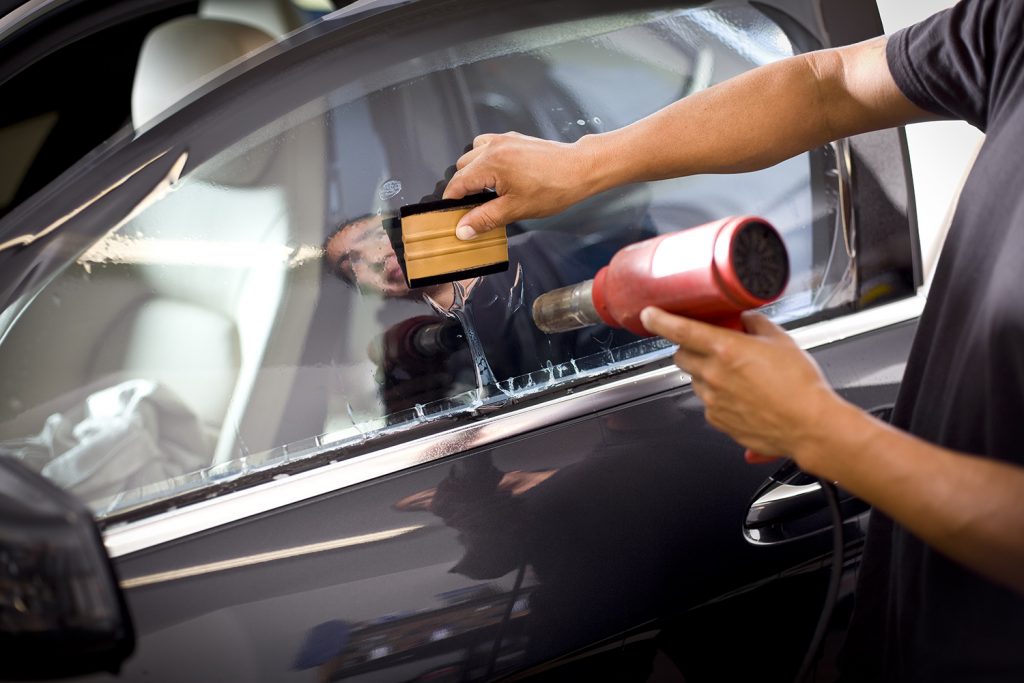Window Tinting Laws: What You Required to Know Prior To Tinting Your Automobile
Window Tinting Laws: What You Required to Know Prior To Tinting Your Automobile
Blog Article
The Process of Expert Window Tinting Explained
From choosing the right film kind to the precise prep work of home windows, each step plays a crucial function in achieving a perfect application. Complying with these first preparations, the careful cutting and application of the film need accuracy to avoid imperfections.
Selecting the Right Home Window Film
The preliminary factor to consider is the type of movie, which can vary from colored, metalized, to ceramic films (window tinting). Colored films largely provide personal privacy and aesthetic enhancement, while metalized movies reflect warmth and UV rays, improving energy effectiveness.
Next, take into consideration the film's Visible Light Transmission (VLT) percent, which figures out just how much light goes into the room. A reduced VLT supplies greater privacy and warm being rejected yet may reduce all-natural light dramatically. In addition, the film's solar heat gain coefficient (SHGC) is critical; a lower SHGC shows better thermal efficiency, assisting to keep indoor convenience.

Preparing the Windows
Once the suitable window film has been picked, the following step is completely preparing the windows for installment. This prep work is vital for accomplishing optimal attachment and making certain a perfect appearance post-installation.
The initial job entails cleaning up the home windows meticulously (window tinting). A premium glass cleanser is important, ideally one that is ammonia-free to avoid damaging any window seals or color products. Making use of a lint-free cloth or paper towels, service technicians need to remove any dirt, dust, or grease, paying special focus to the sides and corners where particles usually builds up

Reducing the Film
An exact method to cutting the movie is essential for guaranteeing a perfect fit on the ready windows. This step requires both ability and attention to information, as mistakes can bring about unpleasant voids or overlaps that compromise the visual and useful qualities of the tint.
Prior to cutting, the professional ought to measure the home window dimensions properly, making up any type of special shapes or contours. It is recommended to utilize high-quality window movie, as this material often tends to be much more flexible throughout the cutting procedure. The film is typically laid level on a tidy, smooth surface area, and a sharp energy knife is utilized to guarantee clean edges.
To achieve optimal results, many experts make use of templates developed from previous installations or use software to create specific patterns. A typical technique includes including an extra margin to the template, permitting for changes throughout the application stage.
Additionally, reducing the movie in a regulated atmosphere decreases the risk of pollutants try these out affecting the sticky side. By adhering to these careful methods, home window tinting experts can guarantee that the movie not just fits perfectly yet additionally performs properly over time, improving both appearance and functionality.
Applying the Color
After meticulously reducing the film to the proper measurements, the following action entails using the color to the window surface. This process starts with making certain that the home window is clean and without any kind of dirt, particles, or deposits that can impact attachment. A specific cleansing service is typically made use of, followed by comprehensive drying out with a lint-free towel.
When the surface is prepared, the installer will thoroughly position the tint film against the glass. It is critical to line up the film precisely to prevent misplacement, as any mistakes can result in a less than professional appearance. To facilitate this, the installer may make use of a light haze of application remedy on the adhesive side of the film, enabling minor repositioning if needed.
Using a squeegee, the installer will certainly then start to press the movie onto the glass, functioning from the facility outwards to remove air bubbles and guarantee a firm bond. This method is important, as it guarantees a smooth and flawless surface. Throughout the application, focus to detail is essential to avoid creases or flaws, making certain that the tint not just improves appearances however additionally offers the desired functionality.
Last Assessment and Treatment
The final examination is a critical step in pop over to this site the window tinting procedure, guaranteeing that the installation meets both aesthetic and useful standards. Throughout this phase, professionals meticulously take a look at the mounted color for any type of blemishes, such as bubbles, folds, or imbalances. A comprehensive examination likewise consists of checking the adherence of the film to the glass, along with its harmony and total appearance.
After the examination, proper care and upkeep directions are provided to the client. It is vital to notify them about the suggested timeline for cleansing the colored home his response windows, typically recommending a wait of at the very least one month after installation to allow the sticky to treat completely. Clients should be educated on suitable cleansing products and techniques, stressing the evasion of ammonia-based cleaners that can harm the color.
Additionally, professionals ought to suggest customers on the importance of routine upkeep to lengthen the life of the tint. This consists of periodic checks for signs of wear or damage and reacting without delay to any issues. By guaranteeing a thorough last examination and offering clear treatment guidelines, window tinting experts improve customer fulfillment and the long life of their job.
Conclusion
The professional window tinting procedure includes several vital steps that ensure high-grade results. Selecting the ideal film type, preparing the home windows thoroughly, precisely reducing the movie, and using it with accuracy are necessary for attaining a remarkable finish.
Report this page